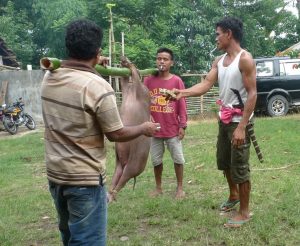 We arrived yesterday at the Nautil, a little cluster of well set up huts run but a Frenchman. The focal point is a lovely thatched shelter, the restaurant, which overlooks the sweep of the bay past vivid paddy and fruit trees. It is very beautiful here, though we are in the rainy season so I find it hard to think what it must look like when it is dry. I imagine it to look like our drive to Riung on Flores in July last year – with fierce orange sun slanting across dry, yellow-brown grasslands and stark shadows cast by volcano cones (though there are no volcanoes on Sumba).
We arrived yesterday at the Nautil, a little cluster of well set up huts run but a Frenchman. The focal point is a lovely thatched shelter, the restaurant, which overlooks the sweep of the bay past vivid paddy and fruit trees. It is very beautiful here, though we are in the rainy season so I find it hard to think what it must look like when it is dry. I imagine it to look like our drive to Riung on Flores in July last year – with fierce orange sun slanting across dry, yellow-brown grasslands and stark shadows cast by volcano cones (though there are no volcanoes on Sumba).
Before we arrived at Nautil we were to visit a funeral to witness the slaughter of a buffalo. The funeral turned out to be of a very poor family, though, one so poor that the dead woman did not tell others of her breast cancer for fear of the expense. It was muddy and wet and the family was too poor to sacrifice more than a single pig. This, along with the fact that they had turned Christian so any Marapu ceremony would be preceded by a very long sermon from a very fat and well-dressed priest meant that we left with a very grumpy guide who has reason to dislike Christian priests.
We went instead to the village of our driver, Panos. Here, his newborn niece was being named in a ceremony in which the baby is offered a choice of several names. The maternal grandparents had also come, bringing with them a pig and a dog for sacrifice, as well as some ikat. We watched the negotiations, led by a hired intermediary and conducted by the distinguished elders, inside the house. It was a cool, clean wooden traditional house, albeit with a tin roof, with jawbones of pigs and boars threaded on the roof beams and a fine collection of spears from Panos’ father’s days as a great hunter. We then went out to watch the sacrifice by the young men, conducted in the space between the houses, with about fifty family members of all ages sitting around and chatting on the porches of the two houses. The dog was tied up in a plastic sack and clubbed over the head so a smear of blood appeared. Then, dead or stunned, it was removed from the sack and its throat cut. Actually it must have been stunned, as blood spurted from the severed neck. It was rather horrific to watch, even though I have seen any number of goats and chickens being slaughtered in the past. They then set the carcass on fire to purify it which was horrific in itself as the stiffened limbs jutted out from flames. At last the carcass was deemed purified and was butchered for consumption at a feast later in the afternoon.
Meanwhile a very healthy pig had been trussed to a long bamboo pole for by the side of the house. It had clearly been tied up for hours on the journey from the maternal grandparents’ village and was largely still, thought it did squeal and struggle occasionally. This pole was hoisted on the shoulders of two of the young men and the pig suspended snout up. The young men lit up a cigarette each. Then, very casually, another young man sauntered up with a machete and speared the pig in the side a few times. The pig squealed and some water was poured over it, I think intended for its mouth. There was very little blood. The pig writhed and was taken off the pole and, like the dog, set on fire – this time without cutting its throat or letting it die fully.
Again it was horrific, and though I feel that if one eats meat one must accept where it comes from, it was nevertheless not easy to see.
We were then invited indoors to a room where Panos’ mother, the second wife, hosted a little lunch for us. We ate surrounded by women, including the first wife, the mother of the baby and others. We were given what is considered the finest Sumba rice, a dry variety, which was extremely aromatic; a plate of noodles cooked with vegetables; and a grilled salted pork belly that had been aged about a year and presumably came from an earlier sacrifice, as that is the only way the Sumba villagers have meat.
Our final stop before proceeding to the Nautil was at Y’s village, to inspect the machete being mounted. It looked very good, quite ornamental, and done entirely by hand, with no mechanised tools such as saws or even drills. It will be ready by the time we are finished with the Nautil and return to Oro beach to catch our flight back to Bali.